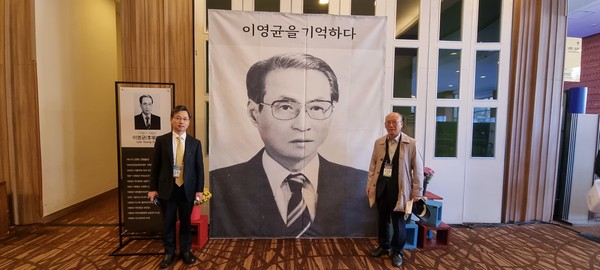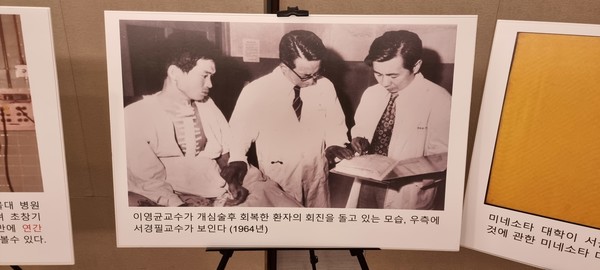Korean thoracic and cardiovascular surgeons recently held an exhibition for the late Dr. Lee Yung-kyoon (1921-1994) to honor his legendary works in the field. Lee is known for introducing lifesaving procedures in heart disease for the first time in Korea and publishing numerous studies that shaped the basics of thoracic and cardiovascular in the nation.
The exhibition held during the Korean Society for Thoracic and Cardiovascular Surgery (KSCVS)'s Fall Conference, held from Thursday to Saturday, showcased some of Lee's achievements and life stories.
Lee pioneered Korea's thoracic surgery by performing a successful open-heart surgery in Korea in 1963.
The exhibition showed how Lee pioneered the field during a time when Korea's medical infrastructure was somewhere between crumbling and non-existent in the 1950s after the Korean War had ravaged the nation.

Korea Biomedical Review met with KSCVS' Chairman of Historical Records, Professor Park Gook-yang, and KSCVS Chief Director, Professor Kim Kyung-hwan, to learn more about Lee and the exhibition.
“Immediately after the Korean War, Korea’s medical situation was generally barren, and even the hospital affiliated with Seoul National University had little medical knowledge,” Kim said. “To help Korea improve its medical infrastructure, U.S. government agency International Cooperation Administration (ICA), the predecessor of the U.S. Agency for International Development (USAID), created the Minnesota Project.”
According to Kim, the project entailed 59 experts from the University of Minnesota in different medical fields coming to Seoul National University (SNU), while sending 226 young health professionals from Korea to the University of Minnesota from 1955 to 1961.
Lee, who worked in the Department of Thoracic Surgery at Seoul National University College of Medicine, was part of the young health professionals who left for training at the University of Minnesota.
"At that time, the University of Minnesota had been known as one of the world's top heart surgery clinics thanks to Professor Clarence Walton Lillehei's heart surgery team,” Kim said.
Lee returned to Korea after receiving training from Professor Lillehei for about two years, Kim added.
However, Korea's situation was still grim as open-heart surgery required special equipment and materials, unlike other surgeries.
"Despite these unfavorable conditions, in 1959, Lee attempted open heart surgery for the first time in Korea. Unfortunately, his first open heart operation failed," Kim said. "The problem was not that the operation was unsuccessful, but the lack of professional manpower and equipment required for surgery."
A lot of medicines and equipment essential for heart surgery was unavailable in Korea at that time.
However, Lee did not give up and kept building up his experiences and capabilities through numerous animal experiments.
"Still, the agony that Lee faced must have been tremendous. Lee wrote about his pain of watching his patients die on the operating table in the letters that he sent to his mentor Professor Lillehei," Kim said.
Finally, in 1963, Lee succeeded in atrial septal defect surgery through open heart surgery for the first time in Korea.
“From what I know, the patient is still alive today," Kim noted.
Afterward, Lee continued to increase the success rate of open-heart surgery and solidified his status as a pioneer in open heart surgery in Korea, Kim added.
Lee's accomplishment was not only limited to thoracic and cardiovascular surgery.
Lee served as the President of Seoul National University Hospital from 1982 to 1996 as the first and only thoracic and cardiovascular surgeon to hold such a position.
During his tenure as the hospital president, he completed the first university hospital-scale children's hospital in Asia, opening a new chapter in pediatric disease education, research, and treatment, and promoted quality management of treatment through expansion of specialized treatment departments.
Kim briefly worked under Lee from 1991 to 1994 when Lee was the director of the now-defunct Sejong Hospital Ilcheon Heart Research Institute. “Ilcheon” was Lee’s pen name.
Kim recalled that Lee used to check up on patients before and after surgery and participated in conference calls to discuss treatment or surgery options for the patient.
Lee was well known for his patient-centric approach.
"From what I heard from my older colleagues, Lee always slept next to his patient after surgery," Kim said. "When a patient was lying in the intensive care unit after surgery, he would not leave his side."
Lee would even put a small bed next to the patient and kept a close eye on the patient's condition until the patient woke up, he added.

Korea's thoracic and cardiovascular surgery has come a long way since
During the interview, Professor Park said thanks to Lee's devotion, Korea's thoracic and cardiovascular surgery department has advanced quickly since Lee's first surgery in 1959.
A few years ago, a newspaper conducted an objective data survey on which clinical department in Korea had the most competitiveness globally.
Various data such as mortality rates were compared using foreign and Korean data, and among such clinical departments, “thoracic surgery was the top,” Park said.
Park stressed that although Lee started in a country ravaged by war right after 6.25, with no food, no medicine, no machines, and no anesthesia, thanks to his devotion, Korea now has a world-class thoracic surgery department.
"The recent cardiac surgery mortality rate is 1-2 percent, a significant improvement even from 7-8 percent reported 20 years ago," Park said. "The quality of the surgery has improved so much that even elderly in their 70s and 80s can now receive heart surgery."
Also, while Lee and many other doctors have gone to the U.S. to learn surgery techniques, now doctors from developing countries often visit Korea to observe and learn Korea's latest surgery methods, Park added.
Thoracic and cardiovascular surgery departments avoided by young doctors
Despite the rich history, Park expressed concerns about the continued decrease in the number of thoracic surgeons specializing in heart surgery in Korea.
Park explained that the number of thoracic surgeons is decreasing as heart surgery operation is long and provides no compensation for overnight operation, while the current medical system has increased the responsibility of the operating surgeon.
"While other surgical procedures are similar, heart surgery is especially difficult even for seasoned surgeons," Park said. "Despite such hardship, a certain surgical method costs the same regardless of the difficulty of the operation."
Due to such unfair pricing, even experts gradually avoid difficult surgery or treatment, which may cause harm to patients, Park added.
Park stressed that the heart is an important organ that deals with life, and as the number of patients is increasing due to the population aging, the number of medical students who respect the craft and have an attachment toward heart surgery should increase.
"Many experts, including myself, must work harder, and the national system must support the fostering of young thoracic surgeons," Park said.

